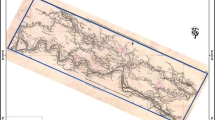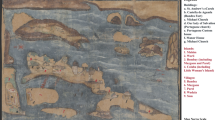Abstract
The port of Kollam (Quilon) in Kerala had been an important trading centre for many centuries. Its significance as a landing point for traders is evident from its colonial history when there were repeated attempts to take over possession of this location. Being an important site, Kollam was frequently mapped by Europeans from the sixteenth to nineteenth centuries. The historical maps and views of Kollam contain vital information about the history, archaeology and geography of the area. Remote sensing and GIS can provide a real-world spatial context to these archived geographical documents of varied scales and types, drawn at different times spanning more than four centuries. The present study harnesses the potential of RS and GIS in integrating information present in the maps of such heterogeneous nature to advance the historical and archaeological knowledge of the Kollam fort. The integration of the maps of the different time, scale and style with the help of RS and GIS yielded information that was previously unknown. The present study has discovered the extant remains of the Portuguese and the Dutch fort that were not identified before and contributed to the scholarship on the construction, restoration, the extent and usage of the fort during its occupation by various European powers.

Satellite Image Courtesy: Google Earth, Maxar Technologies, June 10th, 2018


Source of painting [G]: https://www.atlasofmutualheritage.nl




Similar content being viewed by others
Notes
Factory is a colonial term for entrepôt.
Printmaking techniques use a printing plate (metal or wood) to produce multiple copies of the same image that requires the image on the printing plate to be reversed from what has to be printed (like in a rubber stamp). Unless the engraver skillfully incises or cut the mirror-image of the actual map, the finished print would become a mirror image as in case of Bellin’s map.
Cropmark is one of the main interpretation keys used for satellite image based archaeological exploration. Positive cropmark shows excess growth of vegetation over a ruin or a buried ditch like features. Negative crop marks show retarded growth of vegetation over a buried hard structure.
References
Aiya, V. N. (1906). Travancore State Manual. VED from Victoria Institutions. Retrieved June 21, 2019, from https://archive.org/details/TRAVANCORESTATEMANUAL.
Algeria, M. F., Daveau, S., Garcia, J. C., & Relano, F. (2007). Portuguese cartography in the renaissance. In David Woodward & I. I. I. Volume (Eds.), History of Cartography: Cartography in the European Renaissance. Chicago, London: University of Chicago Press. https://press.uchicago.edu/books/HOC/HOC_V3_Pt1/Volume3_Part1.html.
Baibatsa, A. B. (2014). Paleovalleys mapping using remote sensing. International Archives of the Photogrammetry, Remote Sensing and Spatial Information Sciences, 5, 83–86.
Baldaeus, P. (1672). A true and exact description of the most celebrated east-India Coasts of Malabar and Coromandel as also of the isle of Ceylon (Vol 3, p. 643) Translated from the high Dutch, printed at Amsterdam. https://archive.org/stream/trueexactdescrip00bald#page/n149/mode/2up.
Brovelli, M. A., & Minghini, M. (2012). Georeferencing old maps: A polynomial-based approach for como historical cadastres. e-Perimetron, 7(3), 97–110.
Correa, G. (1858). Lendas da India. Lisboa: Academia Real das Sciencias (Legends of India. Lisbon: Royal Academy of Sciences).
Cotton, J. J. (1946). In B. S. Baliga (Ed.), List of inscriptions on tombs or monuments madras: Possessing historical or archaeological interest (Vol. 2). Madras: Government Press.
Davidson, T. E. (1986). Computer-correcting historical maps for archaeological use. Historical Archaeology, 20(2), 27–37.
Diffie, B. W. (1977). Foundations of the Portuguese Empire, 1415–1580 (p. 472). Minneapolis: University of Minnesota Press.
Galletti, A. (1911). The Dutch in Malabar (being a translation of selections nos. 1 and 2) (p. 49). Madras: Govt. Press. Retrieved June, 2019, from https://archive.org/details/cu31924023942828/page/n17.
Gupta, E., & Rajani, M. B. (2020). Historical coastal maps: Importance and challenges in their use in studying coastal geomorphology. Journal of Coastal Conservation. https://doi.org/10.1007/s11852-020-00739-7.
Gupta, E., Sonia, D., Kuili, S. C. B., Viraj, K., & Rajani, M. B. (2017). The need for a National Archaeological database. Current Science, 113(10), 1961–1973. http://www.currentscience.ac.in/Volumes/113/10/1961.pdf.
Logan, W. (1887). Malabar Manual (1841–1914) (Vol. 1). Madras: Government Press. https://archive.org/details/malabarmanual0000loga/page/322/mode/2up?q=1519.
Mathew, K. S. (2017). Shipbuilding, navigation and the Portuguese in pre-modern India. London: Routledge.
Nieuhof, J. (1744). Voyages and travels into Brasil and the East-Indies. https://ia802907.us.archive.org/24/items/dli.venugopal.428/212.pdf.
Parcak, S. H. (2009). Satellite remote sensing for archaeology (1st ed.). London: Routledge.
Rajani, M. B. (2020). Patterns in past settlements: Geospatial analysis of imprints of cultural heritage on landscapes. Singapore: Springer. https://doi.org/10.1007/978-981-15-7466-5.
Rea, A. (1897). Monumental remains of the Dutch East India Company in the Presidency of Madras. Madras: Government Press.
Schilder, G., Ormeling, F. J., van den Brink, P. P. W. J., Moerman, J., & Ferwerda, H. (2006). Grote atlas van de Verenigde Oost-Indische Compagnie (Comprehensive atlas of the Dutch United East India Company) (Vol. I, VI). Voorburg: Asia Maior, in collaboration with Koninklijk Nederlands Aardrijkskundig Genootschap, Nationaal Archief, Explokart, Fac. Geowetenschappen, Utrecht University, Faculty of Geosciences.
Scott, S. D., Scott, P. K., Smith, James W. F., & MacLeay, J. (2013). Reorientation of historical maps of old fort Niagara using computer-assisted cartography. Journal of Field Archaeology, 18(3), 319–343.
Sever, T. L., & Irwin, D. E. (2003). Landscape archaeology: Remote-sensing investigation of the ancient Maya in the Peten rainforest of northern Guatemala. Ancient Mesoamerica, 14, 113–122.
Suganya, K., & Rajani, M. B. (2020). Riverfront gardens and city walls of Mughal Agra: A study of their locations, extent and subsequent transformations using remote sensing and GIS. South Asian Studies. https://doi.org/10.1080/02666030.2020.1721119.
The Imperial Gazetteer of India. (1908–1931). New edition (Vol. 21, p 22). Oxford: Clarendon Press. Retrieved June 2019, from https://dsal.uchicago.edu/reference/gazetteer/pager.html?objectid=DS405.1.I34_V21_028.gif.
Acknowledgements
We thank Nehru Trust for providing fellowship to the first author to conduct archival work in London. We are thankful to Dr Asmita Mohanty and Ms Renuka for their assistance and guidance during our field visit. We extend our gratitude to Ministry of Earth Science for providing funds to conduct archival work and field visits. Our heartfelt thanks are due to Dr. R.R. Navalgund, for valuable discussions and suggestions. We are grateful to Shailesh Nayak, Director, NIAS, for the institutional support and encouragement. We thank British Library and online archives viz. Atlas of Mutual Heritage, Biblioteca Nacional Digital, Internet Archive, Library of Congress Geography and Map Division for being generous in sharing their material.
Author information
Authors and Affiliations
Corresponding author
Ethics declarations
Conflict of interest
None.
Additional information
Publisher's Note
Springer Nature remains neutral with regard to jurisdictional claims in published maps and institutional affiliations.
Appendix
Appendix
List of historical maps of Kollam fort.
Map no. | Map | Map source and remarks |
|---|---|---|
1 | Hand-made drawing of the Portuguese fortress of Caulao (Quilon), by Gaspar Correia, for his book ‘Lendas da Índia’, written between 1558–1563 and first published in 1858, Volume II, Page no. 394. Accessed on October 2nd, 2019 from purl.pt/12,121/3/var-2326/var-2326_item3/index.html#/412 | |
2 | A Portuguese map, ‘A feitoria de coulao foi fundada por Afonso de Albuquerque em 1503′. From the Atlas- ‘Taboas Geraes De Toda a Navegação’ authored by Albernaz, João Teixeira, Active, Jeronimo De Attayde, and Francisco De Seixas Y Lovera. Publishing year: 1630. Accessed on July 15th, 2019, from: https://www.loc.gov/resource/g3200m.gct00052/?sp=11 | |
3 | A Portuguese map, from the Atlas- ‘Livro das plantas de todas as fortalezas, cidades e povoaçoens do Estado da India Oriental’ by António Bocarro in 1635. Accessed on 15th July from https://purl.pt/27184/3/#/279 | |
4 | A Dutch map, entitled ‘De Stadt Covlang’ from a book titled ''a True And Exact Description Of The Most Celebrated East-India Coasts Of Malabar And Coromandel; As Also Of The Isle Of Ceylon; … with the draughts of their idols, done after their originals’, by Philip Baldaeus, translated from the High-Dutch, printed at Amsterdam, 1672. Accessed on July 16th, 2019, from https://archive.org/details/trueexactdescrip00bald/page/n147 | |
5 | A Dutch map, titled ‘T' Fort Coylan’ represents situation of the fort in 1678, but the map was drafted after 1690, by Isaac de Graaf, for the Atlas Amsterdam. Map and information source Atlas of Mutual Heritage. Accessed on July 20th, 2019, from: https://www.atlasofmutualheritage.nl/en/Maps-forts-Cananor-Cranganor-Coylan-Calicoilan.2583 | |
6 | A Dutch map, titled ‘D'Grond Teekening van de Fortresse Coylan’, created by Hans Georg Taarant, a land surveyor/map maker, in 1687. Accessed on July 16th, 2019, from: https://www.atlasofmutualheritage.nl/en/Representation-Fort-Coylan.2604 | |
7 | Part of a Dutch map, titled ‘De waare afbeelding van de lage landen der Kust Malabaar enz., beginnende boven de fortresse Cranganoor en strekt tot verby de fortresse Coylang enz..Overige topografische namen vermeld op deze kaart: Apare, Patij, Allapaar, Aiwike’, created by Hans Georg Taarant in 1697. Accessed on July 5th, 2019 from: https://www.atlasofmutualheritage.nl/nl/De-kust-Malabaar.2644 | |
8 | A Dutch Plan map, titled ‘Affbeeldinghe hoedanigh de afsnyding off verkleyninge van d'fortresse Coylan gedaen en van zyn tegenwoordigh corpus gesepareert staat te werden’, This is a map of the construction work on the fort with the removal of part of the existing fortifications by Anonymous, made in 1703. Accessed on July 20th, 2019 from: https://www.atlasofmutualheritage.nl/en/Representation-Fort-Coylans-reduction-size.2605 | |
9 | A Dutch map titled ‘De Grond Tekening van de Fortresse Coylan’ by Francois Valentyn, 1724. Accessed on July 10th, 2019 from: https://www.atlasofmutualheritage.nl/en/Map-fort-Coylan.5843 | |
10 | A French map, titled ‘Plan de la Forteresse de Coylan’ by Jacques Nicolas Bellin, 1747. Accessed on June 3rd, 2019 from: https://www.columbihal/bellinquilon/bellinquilon.html Links of its copies published in different years (last accessed on August 25th 2020): | |
11 | A Dutch map, titled ‘De Grond Tekening van de Fortresse Coylan’ by the Van Keulen family in 'De Zee En Land-Caarten en Gizigeten van steeden en landvertooningen van oost-indien', 1752. Accessed on July 2nd, 2019 from: https://www.columbia.edu/itc/mealac/pritchett/00routesdata/1700_1799/malabar/quilon/quilon.html | |
12 | A Dutch map, titled ‘Plan van een geprojecteerde Logie binne Coylan’, created by Zijnen, D. in 1766, representing plan of construction of new fortifications and new lodge buildings. Accessed on July 5th, 2019 from: https://www.atlasofmutualheritage.nl/en/Map-lodge-Coylan.2606 | |
13 | Part of a Dutch map titled ‘Particuliere Kaart van een gedeelte der Kuste Malabar of de strekking der rivieren van Chettua tot Coylan’, created by Graaf, Joh. Wilh. de in 1767. Accessed on July 5th, 2019 from: https://www.atlasofmutualheritage.nl/nl/Kaart-gedeelte-kust-Malabar-deel-A.6099 | |
14 | A Dutch map, titled ‘Plaan van fortres en cituatie van Coylan’ by Anonumous, 1720 (date referred from Schilder G [et al.] 2006, Vol VI). Accessed on July 5th, 2019 from: https://www.atlasofmutualheritage.nl/en/Map-Coylan.6284 | |
15 | Snippet of a British map, from the ‘Atlas of India’ published [London]: J. Walker, 1862. The map444 is published by James Horsburgh (Hydrographer) in 1st May 1829. Accessed on July 20th, 2019 from: https://www.loc.gov/resource/g7650m.gct00196/?sp=22&r=0.31,0.181,0.097,0.042,0 | |
16 | Part of British Admiralty chart, titled ‘Sheet XII. West Coast of India. Malabar Coast from 9° 53′ to 8°. 40′ North Latitude … 1850–2’ published [London]: J. Walker, 1866. Accessed from British Library, Shelfmark: Cartographic Items Maps SEC.12.(750.) | |
17 | A British map, titled ‘Quilon Road’, Surveyed by Lieyt. A.D. Taylor, L.N. 1858, corrected to 1879. The map is found as inset of a British Admiralty chart titled ‘Sheet XII. West Coast of India. Malabar Coast. (Quilon Road. Surveyed … 1858. Corrected to 1879. 1 sea mile[= 56 mm.]). Accessed from British Library, Shelfmark: Cartographic Items Maps SEC.12.(750.) | |
18 | A British map, titled ‘Quilon Road’, Surveyed by Nav. Lieut, T.C. Pascoe, R.N, 1883. The map is found as inset of a British Admiralty chart titled ‘Sheet XII. West Coast of India. Malabar Coast. (Quilon Road. Surveyed … 1883. 1 sea mile[= 55 mm.])’. Accessed from British Library, Shelfmark: Cartographic Items Maps SEC.12.(750.) |
About this article
Cite this article
Gupta, E., Rajani, M.B. Geospatial Analysis of Historical Cartographic Data of Kollam Fort. J Indian Soc Remote Sens 48, 1567–1581 (2020). https://doi.org/10.1007/s12524-020-01181-w
Received:
Accepted:
Published:
Issue Date:
DOI: https://doi.org/10.1007/s12524-020-01181-w






















